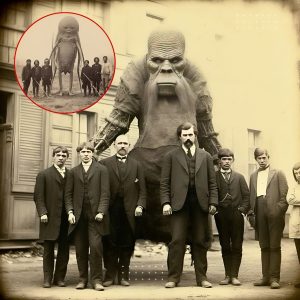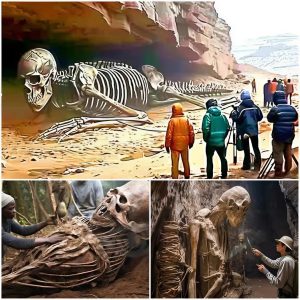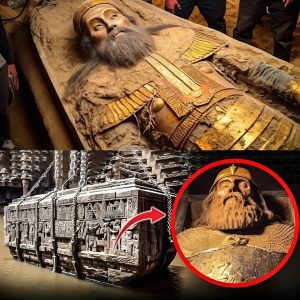In a development that has left the scientific world speechless, archaeologists working in the heart of the Amazon rainforest have discovered the skeletal remains of a giant two-headed creature, changing everything we know about human evolution and the past of planet Earth.
What began as a routine excavation in search of ancient indigenous tribes soon turned into a monumental find. Under meters of dense, jungle-like earth, a colossal skeleton emerged, not of an ordinary human being, but of a humanoid of astonishing proportions, and with a feature never seen before: two perfectly formed skulls!
The skeleton, which reaches an impressive height of 4.5 metres, displays an anatomy outside any known scientific record. Two skulls, connected to a single, massive spinal column, rest on a robust ribcage. The elongated limbs and dense bones suggest unrivalled strength, adding to the mystery of its possible existence in times past.
The discovery has attracted the attention of international experts. Scientists from around the world have flocked to the Amazon to analyse this skeleton, which could forever change our understanding of human evolution. “We have never found anything like this before,” said lead archaeologist Dr Elena Santos. “It is an unprecedented discovery that challenges our current understanding of anatomy and evolution.”
The existence of this two-headed giant raises a multitude of questions. Scientists are perplexed, as the skeletal structure does not fit into any known branch of human evolution. Could it be a lost species from antiquity? Is it possible that mythological and folkloric tales about giants may have had a basis in reality?
Furthermore, some researchers are considering the possibility that this giant is not a simple product of evolution, but the result of some external intervention, whether genetic or even extraterrestrial in origin. The perfectly symmetrical skulls suggest the possible existence of two independent minds in one body, which opens the door to theories never before considered.
Implications for Human History
The discovery of this skeleton is rewriting whole chapters of human history. Some specialists think it could be a race that inhabited the Earth in prehistoric times, before our civilizations emerged. If these two-headed giants once coexisted with humans, it could mean that humanity has shared the planet with other advanced species, whose traces were buried in time.
Folklore and myths from various cultures, from biblical tales to legends of indigenous tribes, speak of giants and even two-headed beings. Until now, these stories had been dismissed as fiction or exaggerations. However, the discovery of this skeleton seems to give them new credibility.
Future Research
As scientists continue to analyze the remains, much remains to be discovered. Future research could shed light on whether this being was a rare genetic mutation, part of an unknown civilization, or even a remnant of an ancient race of giants. The answers that emerge from this analysis could dramatically alter our understanding of the human past and our species’ place in the history of the planet.
This discovery has sparked enormous interest not only in the scientific community, but also among conspiracy theorists and history buffs. While theories about lost civilizations and possible extraterrestrial connections continue to circulate, the world’s attention is focused on the Amazon rainforest and the secrets it still holds.
The discovery of the two-headed giant marks a milestone in archaeology and science, opening new avenues of research and raising fascinating questions. As excavation progresses and studies advance, the world eagerly awaits answers that could forever change the way we understand evolution and human history.
Conclusion
This two-headed giant is not only an archaeological wonder, but also a challenge to modern science. The Amazon rainforest, known for its biodiversity and hidden mysteries, has revealed one of the greatest secrets in history, and its discovery could transform everything we know about our past and human evolution.







